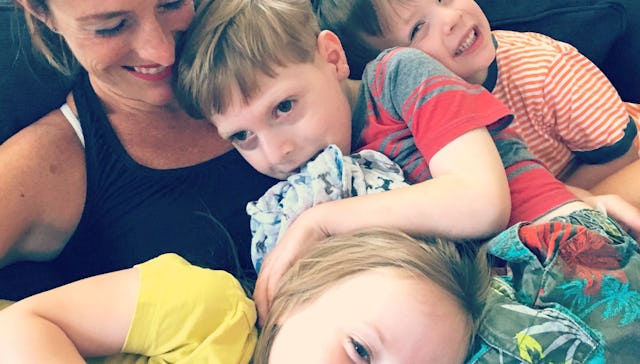My Son Is Nonverbal, And This Is How We Communicate

I’ve submerged myself in “The Americans” lately. It’s a dark and twisty marathon of spy action and intrigue with fun 80s décor. It’s also left me highly paranoid. Who is that breathing down the other end of the line?
If someone were to wire our house though, they might think we’d skipped town. We are a family who falls into silences, like a grandma who trails off mid-sentence, or maybe a misfit group of narcoleptics.
We have our loud moments, of course—yelling to be heard over the “Moana” soundtrack or the cacophony of every single LeapFrog toy spontaneously activating or the fights between my twins over any and all things.
But the most significant conversations take place in the silence.
Charlie, my oldest, is almost non-verbal. He is an amalgam. He blends words on his speaking device with flashcards, sign language, and vigorous gesturing. To watch him talk is like watching ballet, or perhaps a magic show. You’re always waiting for the big reveal. But when all these resources get to be too much, when it’s the end of a long day and he’s just done “working for it”, we resort to the hands. I hold up both hands and we play the “yes no” game. It goes as follows:
Me: “Charlie, do you want Cheerios (hold up left hand) or raisins (hold up right hand)?”
Charlie: Points to left hand.
Me: “Okay, do you want to read Curious George after you eat (left hand) or Madeleine (right hand)?”
Charlie: Eats a Cheerios, pauses, and then taps my right hand.
It’s fast and easy and looks like a game of one-two punch. Is it the most beneficial form of communication for him? No. But it gets the job done.
The twins on the other hand, well, their silences are terrifying. If it gets too quiet in the house and they are not in my line of vision, something’s amiss—something dark and dangerous after which the carpet or the walls will never be the same. And then there’s the twinspeak—the silent conversations they have between the two of them right before my very eyes that almost always involves a plot to overthrow the household or cut the dog’s hair. It’s a radio wave, a frequency to which only they are attuned, and I’ve resorted to waving my hands in front of their faces when I see it, like I’m dispelling a fog.
But of course, my husband and I have our own radio wave too. When it’s 7:30 p.m. and very much bedtime and no one is in pajamas and everyone is begging for a second dessert and he begins to nod, yes, after I am already saying no, this is when eye contact comes in handy. Together we stand. Divided we fall.
This is the weirdness of our family. This is what “typical” looks like for us. It is waves of noise followed by long tides of silence where most of the important stuff happens. In the quiet, we make ourselves known. But it’s not the kind of thing you can pick up as an outsider. This is true of so many things for families with kids with special needs. You have to live it to get it. You have to be an actor in the play to get why it unfolds as oddly as it does.
Because for us, just because it goes unspoken, doesn’t mean it goes unsaid.
This article was originally published on